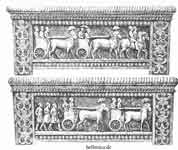.

Limestone sarcophagus: the Amathus sarcophagus, Sarcophagus, Amathus, 2nd quarter of the 5th century B.C.; Archaic
Cypriot
Limestone; Overall: 62 x 93 1/8 x 38 1/2in. (157.5 x 236.6 x 97.8cm)
The Amathus sarcophagus, from Amathus, Cyprus, arguably the single most important object in the Cesnola Collection, is unique among ancient Cypriot sculptures in its monumentality and in the preservation of its polychromy. It probably belonged to one of the kings of Amathus. The primary scenes, on the long sides, show a procession of chariots escorted by attendants on horseback and followed by foot soldiers. The main personage is probably the driver, who is standing under a parasol in the first chariot. His horses, like the others, are richly caparisoned; his chariot resembles the others as well, except that the wheel has fewer spokes. The decoration of the short ends of the sarcophagus consists of a row of Astarte figures, nude except for their double necklaces and ear caps, and a row of Bes figures. The choice of these two deities - one Near Eastern, the other Egyptian - suggests the importance of procreation to the deceased. The figural panels are framed by a variety of vegetal ornaments, while the gabled lid once featured a pair of sphinxes and a palmette at each end. The iconography as a whole documents the thorough integration of Greek, Cypriot, and Oriental features in middle fifth century B.C. works of high quality.
Source This image was originally posted to Flickr as Amathus sarcophagus-Cyprus-5th century BC
Date December 30, 2005
| Ancient Greece
Science, Technology , Medicine , Warfare, , Biographies , Life , Cities/Places/Maps , Arts , Literature , Philosophy ,Olympics, Mythology , History , Images Medieval Greece / Byzantine Empire Science, Technology, Arts, , Warfare , Literature, Biographies, Icons, History Modern Greece Cities, Islands, Regions, Fauna/Flora ,Biographies , History , Warfare, Science/Technology, Literature, Music , Arts , Film/Actors , Sport , Fashion --- |



